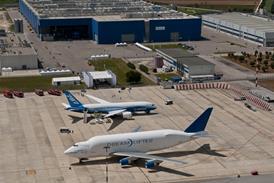An oil pipe failure in the number three engine control mechanism has been blamed for the crash of the prototype Antonov An-70 tactical transport aircraft in Omsk, Siberia, earlier this year, according to the Russian State Commission, which is investigating the crash.
The pipe's failure in the propeller-hub led to a runaway acceleration of the rear propeller in the Progress D-27 propfan engine, causing high drag and severe vibration. The crew's efforts to compensate for the problem led to an automatic shut-down of the number one powerplant. Following the loss of two engines, the sole remaining An-70 was force-landed, causing significant damage.
The report has been endorsed by Yury Koptev, general director, Russian Aerospace Agency. A failure of the engine deicing systems was initially cited as a possible cause of the crash by Fyodar Murav-chenko, Progress general designer. The engines have been repaired and are ready for re-installation, Muravchenko says.
Antonov says that the propeller hub where the pipe failure occurred, and the wiring and software for the control system, were manufactured by different Russian companies. The company declines to attribute blame for the failure.
The cost of repairing the crashed An-70 is estimated to be $2 million, with repairs due to be completed by the end of this month. The aircraft should fly again in May, and is slated to appear at the Paris air show.
The STS An-70 consortium, which is marketing the aircraft, is to acquire three additional engines for further testing. Two aircraft are under construction at Aviant in Kiev, alongside the fourth aircraft, a commercial prototype. Serial production is scheduled to begin next year, with five aircraft to be built at the two production plants in Samara, Russia.
Source: Flight International























